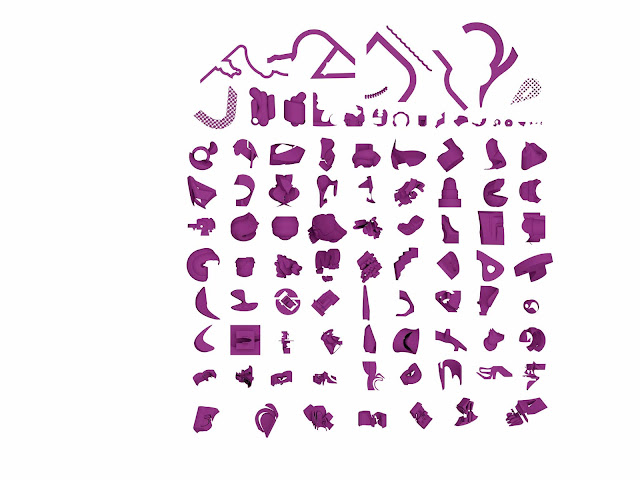T4T LAB Spring 2018. Rough and Saturated
Invited Professor: Nate Hume
Team: Maria Fuentes, Sidney Farris, Ozzy Carrion and Ashley Fulcher.
Hotdog Machine
Although
we approached this project as an issue of degree, the project developed into a
way of observing tropes of kind within an architectural perception of the
estranged and the familiar. This studio is mainly an exploration of the
both/and; the rough and saturated. The studio focuses primarily on the rough
and saturated; the both/and; the strangely familiar. The site is located North
of Texas A&M’s West Campus, on university-owned agricultural land. The
project introduces a new culture to the context, while using a familiar,
banal program related to animal and food sciences, in our case, a new
building for the entomology department. We were interested in the intersection
of subject/object + nature/culture, by determining the relationships of objects
that become familiarized through four tiers of exhaustion: movement, geometry, space, and texture. The mereology of the
familiar canonizes the creation of categorical elements. Through our project,
we’ve utilized postural catalysts such as embedding, imposition, and hovering. With these catalysts, we can
use the four tiers of exhaustion to evaluate relationships according to degree.
We embed
the ground hot dogs in the site, producing a second ground in which the
ensemble is embedded. Through posturing the ground and the ensemble, they are
exhausted of their original character. This occurs at the macro Level. At the
micro level, these same figures, the hot dogs, can be seen as the smallest
member of the categorization; becoming a successful field object that aids in
creating inner-outer-inner moments.
In this
composition, the hot dogs are the autopoietic machine which occupies the
anchored, designed objects. This mereology relates to the other objects to
produce more. The relationships of the hot dogs at the micro scale catalyze the
autopoietic machine, as the program begins to be introduced as a new part of
the machine, the entirety shifts to become allopoietic, necessary to be
represented by the drawings, plans, and section.
The
components of the ensemble are first interpreted through degree (size, color,
shape) before being evaluated on the basis of kind. This is an onticological
method of intuition. Through the use of bergsonist concept of duration, we use
this technique as a filter to think about the question the ensemble proposes,
not as an issue of degree, but an issue of kind.
The first
tier of embedding began with the figures, then texture and color, finally
program. Because of the onticology of the building, the progression to the
final tier of exhaustion (the program) is the last phase in the series of
shifts (phase) the building undergoes. The system is open, allowing in all
objects until the program becomes an object that inhibits the acceptance of new
members; specifically stemming from the central hot dog nucleus.
When the
onticology of the building becomes apparent; it is then that the inhibition of
the autopoietic machine begins. This begins to wane on the ensemble, leading to
the machine becoming allopoietic. It creates not itself,
but something other. We are interested in wanting to know the deeper
understanding of the relationship between these objects within the threshold of
subject/object & nature/culture areas.















